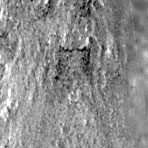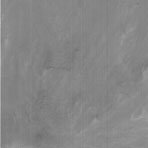 |
|
|
|
|
|
|
|
Without question, Mars is a weird world. Since there are no oceans currently covering it, the land surface area is greater than the entire Earth's even though the planet is smaller. Which means there's room for a whole lot of strange stuff up there. There are huge mountains, immense chasms, vast dune-filled deserts and cracked, featureless plains. Dust-choked craters and tortured landscapes tell of cataclysms lost in the forgotten depths of time and its relentless passage. And there are bizarre things that look like forests and vegetation, too.
If our presence on Earth is any guide, then in looking for signs of past intelligent inhabitation in this sandy expanse, we should seek lingering rectilinear features, squares, rectangles, and connecting lines. Such have been seen on Mars for a long time: Perceval Lowell thought he saw canals too regular and ordered to be anything less than intelligently-designed. Alas, Mariner and Viking and the probes since proved that this was not so. Yet the basic principle is sound, as any flight over inhabited portions of our own world will reveal.
However, among all the strange formations that might be some kind of archeological remains, nothing so simple or definite as a square has been found. Until now.
D&M Pyramid, showing location of "door."
Recently, Malin Space Science Systems released a composite photo of the "D&M Pyramid," which to my eye anyway, seems to show a large, rubble-filled doorway on its southern facet.
Named after its discoverers, Vincent DiPietro and Greg Molenaar, the D&M Pyramid is doubtless the most closely scrutinized Cydonian feature after the nearby Face itself. As an unusual polygonal pyramid-shaped butte, its angular shape and the alignment of its faces has brought much attention from many researchers since the earliest days. The fact that Malin made this composite is indicative of the intense and continued interest in this feature.
And though its rarely been mentioned before, there's a square smack-dab in the middle of it. It does not seem to be a digital artifact, an effect of photography or problems in transmission. A close examination of such a data-square shows that those edges are completely straight, even when its composed of actual image pixels that have been misplaced or distorted, whereas this has a much rougher and "realer" form.
Could the square then be a deliberate digital insertion? This seems unlikely as it appears on the composite's source, which is a poor shot that needed much enhancement, but the square is still visible. On the right below is the unaltered section of that image, which was rotated nearly 180 degrees and mated with two other scans — neither which covers the area of the "door" — to form the composite image.The square appears to be an actual part of the landscape. It is slightly lighter above, as if there is a overhanging lintel casting a shadow, and a flow of material obscuring the lower edge. Nevertheless, with its three definite sides and slightly darker shading, if this isn't a filled-up hole into the side of this mound, what is it?

The Door from the composite, contrast enhanced

The Door on original, unenhanced and unrotated
Whatever it is, it's big — if the entire image is 5 miles across, as is stated on the page at MSSS, then a simple pixel-count reveals that the square must be on the order of 300 feet across. Though there is a debris flow below it, there is no appearance of a ramp or other means of surface access. Maybe it was only to be reached in spacecraft. Richard Hoagland speculates from the infrared data that the slumped sections give off more energy that the rest of the structure. Perhaps it's still occupied...
But why wasn't it noticed before?
Though as wide as a football field, the Door is a comparatively small and subtle mark on the massif's flank. There are few good pictures of it, nonetheless it can occasionally be made out, once one knows where to look. A bigger, more cynical question might be: How come MSSS didn't catch it when they composed and posted the image? Or could this too, be a part of the gradual disclosure that we are not alone?